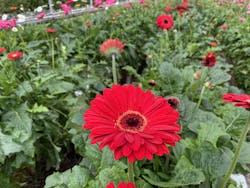When you run a commercial greenhouse and decide to expand the variety of flowers and vegetables beyond the roses you’ve primarily cultivated, it might be a good idea to bring in flexible lighting that could deliver different photon recipes to different crops.
That’s what Canadian grower Rose Drummond is doing, turning to Montreal-based Sollum Technologies for an LED system that will enable it to adjust spectra, intensity, and duration as it ramps up operations in gerberas, alstroemerias, tomatoes, and cucumbers while also fortifying its rose growing.
Known primarily as a rose grower since its founding in 1986, Rose Drummond began moving into vegetable crops about a decade ago. In 2020, new owner Groupe Soucy decided upon a wider expansion. Gerberas and alstroemerias entered the picture, and cucumbers and tomatoes became a solid part of the plan.
The broader array matched the character of Soucy, a privately held diversified company with a mix of products including rubber, iron, and vehicle parts that it sells to various sectors including defense, agricultural, industrial, and defense.
Rose Drummond, based in Drummondville some 67 miles east of Montreal, is not going all LED for now. It will install LED toplights in a roughly 1,000m2 portion of the 4,175m2 greenhouse space, with intentions of eventually outfitting the remainder with the LED fixtures, according to Sollum. The fittings measure about 36 in. long × 4 in. wide × 5.8 in. high. Drummond hopes to switch on the new system in August.
The LEDs replace high-pressure sodium lights above the gerberas and cucumbers. Drummond is not concerned that the cooler-running LEDs will deprive the greenhouse of what can be useful heat emitted by less efficient HPS sources. Rather, Drummond believes the energy efficiency and variable spectrum benefits of the LEDs will far outweigh any disadvantage from the heat loss. Some growers go with a mix of HPS and LED to help maintain heat.
Currently, the other crops at the Drummond greenhouse are not artificially lit, so the Sollum LEDs are their entrée to grow lights.
A Sollum control system will allow Drummond to vary the light make-up over the different crops, using different optimal recipes for each. The system includes sensors that read incoming light levels and spectral composition, which then adjust the LED output accordingly, Sollum told LEDs Magazine.
The idea is to supplement natural light in a way that extends the growing season year-round and improves product quality. For the vegetables, Drummond aims for shorter cycle times, higher fruit count, and better control of size. For the flowers, the grower intends to improve size, color density, and shelf life, as well as to shorten cycle times. In the case of the alstroemerias, it also hopes to increase flower yields.
Sollum declined to say how many LED fittings it is providing, or how much Rose Drummond is paying. Sollum offers pricing on both a product and a service basis via its SUN as a Service offering, which includes a cloud platform loaded with information on light recipes for different crops, and on the sun’s morning-to-evening spectral patterns anywhere in the world. (The SUN as a Service technology has won a past LEDs Magazine Sapphire Award for horticultural lighting product innovation). Growers can adjust settings from phones and tablets. Service also includes support and software updates.
A Sollum spokesperson told LEDs that the sale to Rose Drummond was mainly on a product basis, with SUN as a Service representing “a small portion of the total.”
MARK HALPER is a contributing editor for LEDs Magazine, and an energy, technology, and business journalist ([email protected]).
For up-to-the-minute LED and SSL updates, follow us on Twitter. You’ll find curated content and commentary, as well as information on industry events, webcasts, and surveys on our LinkedIn page and our Facebook page.






